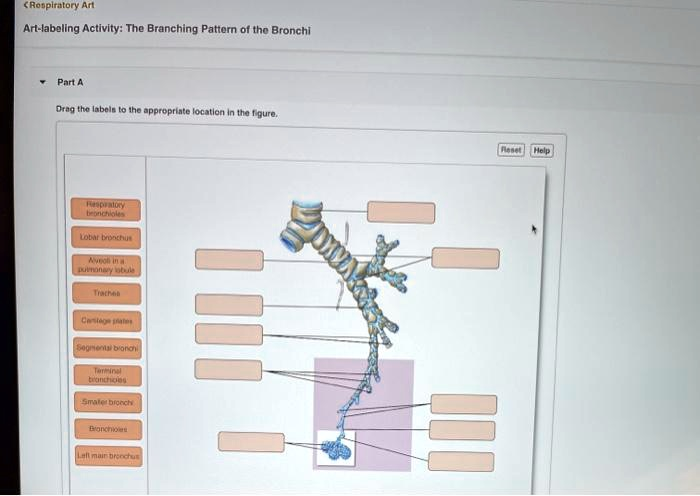<Respiratory Art Art-labeling Activity: The Branching Pattern of the Bronchi Part A Drag the labels to the appropriate location in the figure. Respiratory bronchioles Lobar bronchus Alveoli in a pulmonary lobule Trachea Cartilage plates Segmental bronchi Terminal branchioles Smaller bronchi Bronchioles Left main bronchus Reset Help

The Correct Answer and Explanation is:
Based on the diagram and labels you provided, here’s the correct labeling of the branching pattern of the bronchi:
Trachea – The large central airway at the top
Left main bronchus – The first major branch leading to the left lung
Lobar bronchus – The secondary branches that lead to individual lobes
Segmental bronchi – The tertiary branches serving specific lung segments
Smaller bronchi – Further subdivisions after segmental bronchi
Bronchioles – Narrower airways branching from the smaller bronchi
Terminal bronchioles – The final conducting branches before gas exchange begins
Respiratory bronchioles – The first structures in the respiratory zone
Alveoli in a pulmonary lobule – Tiny sacs involved in gas exchange
Cartilage plates – Reinforcing structures in the walls of bronchi
Explanation The respiratory system features an efficient branching pattern that ensures air is distributed evenly throughout the lungs. The process begins with the trachea, a reinforced airway that conducts air into the thoracic cavity. It bifurcates into two primary bronchi, each entering a lung. In the image, the left main bronchus is shown branching toward the left lung.
Once inside the lung, the main bronchus divides into lobar bronchi, with each one supplying a lobe. These branches then divide further into segmental bronchi, which serve more localized regions known as bronchopulmonary segments. As the divisions continue, the bronchi become smaller, ultimately forming bronchioles.
Bronchioles are notable for lacking cartilage and leading to terminal bronchioles. These terminal structures mark the end of the conducting zone. They transition into respiratory bronchioles, which contain some alveoli and represent the beginning of the gas exchange zone. These respiratory bronchioles then give rise to alveolar ducts and finally to alveoli clustered within pulmonary lobules.
Alveoli are the microscopic sites where oxygen diffuses into capillaries and carbon dioxide exits the bloodstream. Cartilage plates embedded within the bronchi provide structural integrity, helping to maintain open pathways throughout respiration. This intricate, tree-like design is key to effective breathing and metabolic exchange.
